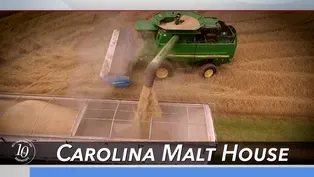
The History of The Landsford Canal
Clip: Season 10 Episode 22 | 5mVideo has Closed Captions
Discover the why behind the construction of Landsford Canal along the Catawba River.
Discover why Landsford Canal was constructed in the 1820's, learn more about Landsford Canal State Park, and the annual blooming of the Rocky Shoal Spider Lillys. The History of The Landsford Canal, only on Carolina Impact.
Problems with Closed Captions? Closed Captioning Feedback
Problems with Closed Captions? Closed Captioning Feedback
Carolina Impact is a local public television program presented by PBS Charlotte

The History of The Landsford Canal
Clip: Season 10 Episode 22 | 5mVideo has Closed Captions
Discover why Landsford Canal was constructed in the 1820's, learn more about Landsford Canal State Park, and the annual blooming of the Rocky Shoal Spider Lillys. The History of The Landsford Canal, only on Carolina Impact.
Problems with Closed Captions? Closed Captioning Feedback
How to Watch Carolina Impact
Carolina Impact is available to stream on pbs.org and the free PBS App, available on iPhone, Apple TV, Android TV, Android smartphones, Amazon Fire TV, Amazon Fire Tablet, Roku, Samsung Smart TV, and Vizio.

Introducing PBS Charlotte Passport
Now you can stream more of your favorite PBS shows including Masterpiece, NOVA, Nature, Great British Baking Show and many more — online and in the PBS Video app.Providing Support for PBS.org
Learn Moreabout PBS online sponsorship(lighthearted music) - [Terzis] Commerce and trade often go hand in hand with the development of infrastructure.
Along the Catawba River, there's a unique state park known for both its natural beauty and for a 19th century engineering marvel.
- Today we are at Landsford Canal State Park, here in Rock Hill, South Carolina.
- [Terzis] The park encompasses just over 400 acres on either side of the river.
- The most popular thing that people come here for is the Rocky Shoal Spider Lilies.
- [Terzis] The shallow rocky shoals along this section of the Catawba River makes a great habitat for the spider lilies.
But back in the early 1800s, these shoals created a barrier for commerce and trade.
With the industrial revolution in full swing, textile mills in the northern United States and Europe had an almost insatiable appetite for South Carolina's primary cash crop, cotton.
But the Palmetto State needed an efficient transportation network to get this fluffy white stuff to market.
- [Al James] So they surveyed all the river systems in South Carolina and determined that they could get goods down to Charleston from the upstate if you built bypass canals around the shoals.
This canal right here bypassed about two and a half miles of shoals.
- [Terzis] Prior to the canal's construction, this site was the home of William R Davie, who had served in the Revolutionary War and later, as governor of North Carolina.
According to James, Davie chose the land with the intent to build a water-powered mill.
- He built a mill here so that he could grind corn and also had a sawmill on the outside of it.
And as when he built the mill, he designed it with a mile long mill race, which is where, how the water gets from the river through basically a canal or ditch to the mill site so that it can run the wheel to grind the corn or run the sawmill.
- [Terzis] Davie's mill race provided engineers with a head start.
- [James] There was already a mile long canal here, so this became one of the easiest places or choices for them to build one, because they only had to put another mile and a half down below it to get the boats back out into the river on the bottom side of the fall.
- [Terzis] The state of South Carolina paid just over $120,000 to build Landsford Canal, with plans drawn up by American architect, Robert Mills.
He's perhaps best well known for designing the Washington Monument.
The actual construction work took about three years, using both enslaved African Americans and Northern stone masons.
According to James, Landsford Canal opened 200 years ago in 1823 and was considered critical infrastructure with a big economic advantage over other transportation means of the day.
- [James] You basically needed a way to get these goods and services down to a port as efficiently as possible.
If we're about 225 miles from Charleston, you pretty much figure boats probably moved about walking speed.
It's gonna, it's gonna take a long time to get that materials down there.
But when you're doing it with wagons, it's basically the same thing.
There, you're not putting strain on animals, you're basically just going with the flow.
- [Terzis] And going with the flow starts here.
- [James] You have an entrance up here.
It's kind of hard to see, but this is a diversion dam.
There's a basic pile of rocks that they just hand piled out there in the river about three quarters of the way across, and it was designed to get the water level on this side a little bit higher so that the water would go into the canal.
Once you got to the lifting locks, this lifting lock down here is about 200 feet long and drops about 18 feet in two stages.
The assumption on these canals are that they were pretty much one way traffic.
One of the cool little tidbits is when all these boats delivering goods got down to Charleston, they took the boats apart, loaded the wood onto wagons, brought 'em back up here, rebuilt the boats, floated 'em down the water.
This canal operated from about 1823, was its initial opening, to about 1831 to 35.
We've got records that show that the employee that worked here was called a bank ranger, and his last payment was in about 1835, 1836.
- [Terzis] The canal only operated for a little more than a decade.
It and other canals in South Carolina were made obsolete, thanks to railroads.
- When the railroads started coming in South Carolina in 1831, I think the main, the first line was, they called it the Hamburg Line, which would've been from Augusta to Columbia.
And once they started spurring off of that and running down to the coast, they found that that was a lot speedier and a lot more secure way to get the goods down to the coast for shipping.
- [Terzis] For Carolina Impact, I'm Jason Terzis reporting.
Benny's Backyard Welding & Yard Art
Video has Closed Captions
Clip: S10 Ep22 | 3m 56s | We visit with self-taught welder & artist Benny Reeder of Benny's Yard Art in Huntersville (3m 56s)
Video has Closed Captions
Clip: S10 Ep22 | 6m 17s | Charlotte based Profound Gentlemen works to keep male educators of color in the classroom. (6m 17s)
Video has Closed Captions
Clip: S10 Ep22 | 5m 55s | Why so many great craft beers start with Carolina malt and barley from Rowan County. (5m 55s)
Carolina Impact: April 25th, 2023
Preview: S10 Ep22 | 30s | Charlotte's brewery business, Profound Gentlemen, Landsford Canal, & artist Benny Reeder. (30s)
Providing Support for PBS.org
Learn Moreabout PBS online sponsorshipSupport for PBS provided by:
Carolina Impact is a local public television program presented by PBS Charlotte














